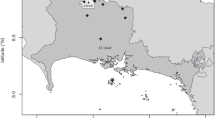Abstract
Species of Cryptocoryneum were taxonomically reassessed on the basis of morphological observations and the results of molecular phylogenetic analysis. Eighteen isolates of Cryptocoryneum species, namely two strains from Africa, three from Europe, and 13 from Japan, were phylogenetically analysed using sequences of nuclear rDNA internal transcribed spacers (ITS) and the partial sequence of the translation elongation factor 1α gene (TEF1). The phylogenetic analysis indicated that Cryptocoryneum species formed a monophyletic clade and were closely related to Lophiotrema (Lophiotremataceae) and Aquasubmersa (incertae sedis) in the Pleosporales (Dothideomycetes). We examined holotype specimens of C. fasciculatum, C. hysterioides, and Torula uniformis and concluded that these species are conspecific, with C. hysterioides having priority. Although C. hysterioides has long been regarded as a synonym of C. condensatum, we consider C. hysterioides to be a distinct species within the genus. We found several cryptic species that were morphologically similar to C. condensatum sensu lato, but that could be separated on the basis of conidial size and the number of conidial arms and conidial septa, characters that seem to be informative for species delimitation within Cryptocoryneum. A total of seven new species, namely C. akitaense, C. brevicondensatum, C. congregatum, C. japonicum, C. longicondensatum, C. paracondensatum, and C. pseudorilstonei, are described and illustrated. A key to species accepted in Cryptocoryneum is provided.



Similar content being viewed by others
References
Akaike H (1974) A new look at the statistical model identification. IEEE Trans Autom Contr 19:716–723
Corda ACJ (1837) Icones fungorum hucusque cognitorum, vol 1. J.G. Calve, Prague
Endo M, Hatakeyama S, Harada Y, Tanaka K (2008) Description of a coelomycete Ciliochorella castaneae newly found in Japan and notes on its distribution and phylogeny. Nippon Kingakukai Kaiho 49:115–120 (in Japanese)
Ellis MB (1963) Dematiaceous hyphomycetes. IV. Mycol Pap 87:1–42
Ellis MB (1971) Dematiaceous hyphomycetes. Commonwealth Mycological Institute, Kew
Ellis MB (1972) Dematiaceous hyphomycetes. XI. Mycol Pap 131:1–25
Fuckel L (1865) Fungi Rhenani Exsiccati Cent. XV–XVI:1401–1600
Hansford CG (1956) Australian Fungi. III. New species and revisions. Proc Linn Soc N S W 81:23–51
Hashimoto A, Sato G, Matsuda T, Hirayama K, Hatakeyama S, Harada Y, Shirouzu T, Tanaka K (2015a) Molecular taxonomy of Dinemasporium and its allied genera. Mycoscience 56:86–101
Hashimoto A, Sato G, Matsuda T, Matsumura M, Hatakeyama S, Harada Y, Ikeda H, Tanaka K (2015b) Taxonomic revision of Pseudolachnea and Pseudolachnella and establishment of Neopseudolachnella and Pseudodinemasporium gen. nov. Mycologia 107:383–408
Hatakeyama S, Tanaka K, Harada Y (2008) Bambusicolous fungi in Japan (7): a new coelomycetous genus, Versicolorisporium. Mycoscience 49:211–214
Hennings PA (1908) Fungi S. Paulensis IV a cl. Puttemans collecti. Hedwigia 48:1–20
Hirayama K, Tanaka K (2011) Taxonomic revision of Lophiostoma and Lophiotrema based on reevaluation of morphological characters and molecular analyses. Mycoscience 52:401–412
Hughes SJ (1958) Revisiones hyphomycetum aliquot cum appendice de nominibus rejiciendis. Can J Bot 36:727–836
Hughes SJ (1978) New Zealand Fungi 25. Miscellaneous species. N Z J Bot 16:311–370
Jobb G (2011) Treefinder Mar 2011. Available at http://www.treefinder.de
Kamiyama M, Hirayama K, Tanaka K, Mel’nik VA (2009) Transfer of Asterosporium orientale to the genus Prosthemium (Pleosporales, Ascomycota): a common coelomycetous fungus with stellate conidia occurring on twigs of Betula spp. Mycoscience 50:438–441
Katumoto K (1988) Materials for the fungus flora of Japan (43). Trans Mycol Soc Japan 29:359–362
Kirk PM (1982) New or interesting microfungi. V. Microfungi colonizing Laurus nobilis leaf litter. Trans Br Mycol Soc 78:293–303
Kirk PM (1983) New or interesting microfungi. X. Hyphomycetes on Laurus nobilis leaf litter. Mycotaxon 18:259–298
Mel’nik VA (2000) Definitorium fungorum Rossiae. Classis hyphomycetes. Vol. 1. Fam. Dematiaceae, Nauka, Sankt-Peterburg (in Russian)
Oudemans CAJA (1892) Contributions á la flore mycologique des Pays-Bas. XIV. Nederl kruidk Archf, Ser. 2, 6:1–65
Peck CH (1880) Report of the Botanist. Ann Rep N Y State Mus Nat Hist 33:11–49
Peyronel B (1918) Micromiceti di Val Germanasca. Nuovo G Bot Ital 25:405–464
Prostakova M (1966) Species fungorum novae in plantis fructiferis et bacciferis moldaviae. Infektsioznye Zabolevaniya Kulturnykh Rastenii Moldavii Infekts Zabol kul'tur Rast Mold 6:10–12 (in Russian)
Rambaut A, Suchard MA, Xie W, Drummond AJ (2014) Tracer 1.6. Available at http://beast.bio.ed.ac.uk/Tracer
Rayner RW (1970) A mycological color chart. Commonwealth Mycological Institute and British Mycological Society, Kew
Rehner SA, Buckley E (2005) A Beauveria phylogeny inferred from nuclear ITS and EF1-alpha sequences: evidence for cryptic diversification and links to Cordyceps teleomorphs. Mycologia 97:84–98
Ronquist F, Teslenko M, van der Mark P, Ayres DL, Darling A, Höhna S, Larget B, Liu L, Suchard MA, Huelsenbeck JP (2012) MrBayes 3.2: efficient Bayesian phylogenetic inference and model choice across a large model space. Syst Biol 61:539–542
Saccardo PA (1892) Sylloge Fungorum omnium hucusque cognitorum 10. Published by the author, Berlin
Saccardo PA (1920) Mycetes Boreali-Americani a cl. Doct. J.R. Weir (Spokane, Washington) an. MCMXIX communicati. Nuovo G Bot Ital 27:75–88
Sato G, Tanaka K, Hosoya T (2008) Bambusicolous fungi in Japan (8): a new species of Pseudolachnella from Yakushima Island, southern Japan. Mycoscience 49:392–394
Sawada K (1943) Descriptive catalogue of Formosan fungi. Part IX. Rept Dep Agr Gov Res Inst Formos 86:1–178
Schoknecht JD, Crane JL (1977) Revision of Torula and Hormiscium Species. Torula occulta, T. diversa, T. elasticae, T. bigemina and Hormiscium condensatum reexamined. Mycologia 69:533–546
Schwarz G (1978) Estimating the dimension of a model. Ann Stat 6:461–464
da Silva SS, Gusmão LFP, Castañeda-Ruiz RF (2015) Cryptocoryneum parvulum, a new species on Araucaria angustigolia (Brazilian pine). Mycotaxon 130:465–469
Talbot PHB (1952) Dispersal of fungus spores by small animals inhabiting wood and bark. Trans Br Mycol Soc 35:123–128
Tamura K, Peterson D, Peterson N, Stecher G, Nei M, Kumar S (2011) MEGA5: molecular evolutionary genetics analysis using maximum likelihood, evolutionary distance and maximum parsimony methods. Mol Biol Evol 28:2731–2739
Tanabe AS (2011) Kakusan4 and Aminosan: two programs for comparing nonpartitioned, proportional and separate models for combined molecular phylogenetic analyses of multilocus sequence data. Mol Ecol Resour 11:914–921
Tanaka K, Endo M, Hirayama K, Okane I, Hosoya T, Sato T (2011) Phylogeny of Discosia and Seimatosporium and introduction of Adisciso and Immersidiscosia genera nova. Persoonia 26:85–98
Tanaka K, Hirayama K, Yonezawa H, Sato G, Toriyabe A, Kudo H, Hashimoto A, Matsumura M, Harada Y, Kurihara Y, Shirouzu T, Hosoya T (2015) Revision of the Massarineae (Pleosporales, Dothideomycetes). Stud Mycol 82:75–136
Tanaka K, Mel’nik VA, Kamiyama M, Hirayama K, Shirouzu T (2010) Molecular phylogeny of two coelomycetous fungal genera with stellate conidia, Prosthemium and Asterosporium, on Fagales trees. Botany 88:1057–1071
von Heftberger M, Mayrhofer H, Scheuer C (1997) Neuere Funde von Cryptocoryneum condensatum (Hyphomycetes, mitospore Pilze) aus Österreich und Slowenien. Mitt Naturwiss Ver Steiermark 127:61–64
Viala P (1891) Monographie du pourridié (Dematophora). Librarie de L’Académie de Médecine, Montpellier
Wallroth CFW (1833) Flora Cryptogamica Germaniae II. J.L. Schrag, Norimbergae
White TJ, Bruns T, Lee S, Taylor JW (1990) Amplification and direct sequencing of fungal ribosomal RNA genes for phylogenetics. In: Innis MA, Gelfand DH, Sninsky JJ, White TJ (eds) PCR protocols: A guide to methods and applications. Academic, New York, pp 315–322
Wijayawardene DNN, McKenzie EHC, Hyde KD (2012) Towards incorporating anamorphic fungi in a natural classification–checklist and notes for 2011. Mycosphere 3:157–228
Yonezawa H, Tanaka K (2008) A second species of Neoheteroceras and additional characters of the genus. Mycoscience 49:152–154
Acknowledgments
The authors gratefully acknowledge the following herbaria for the loan of material; G, IMI, NYS, PRM, and UPS. We wish to thank editors and anonymous reviewers for constructive comments on the manuscript. We also thank V.A. Mel’nik for providing valuable information about Cryptocoryneum lignicola. This work was partially supported by grants from the Japan Society for the Promotion of Science (JSPS, 25440199 and 26291084) and Hirosaki University Grant for Exploratory Research by Young Scientists.
Author information
Authors and Affiliations
Corresponding author
Additional information
Section Editor: Roland Kirschner
Rights and permissions
About this article
Cite this article
Hashimoto, A., Matsumura, M., Hirayama, K. et al. Taxonomy and phylogeny of Cryptocoryneum (Pleosporales, Dothideomycetes). Mycol Progress 15, 45 (2016). https://doi.org/10.1007/s11557-016-1186-8
Received:
Revised:
Accepted:
Published:
DOI: https://doi.org/10.1007/s11557-016-1186-8




